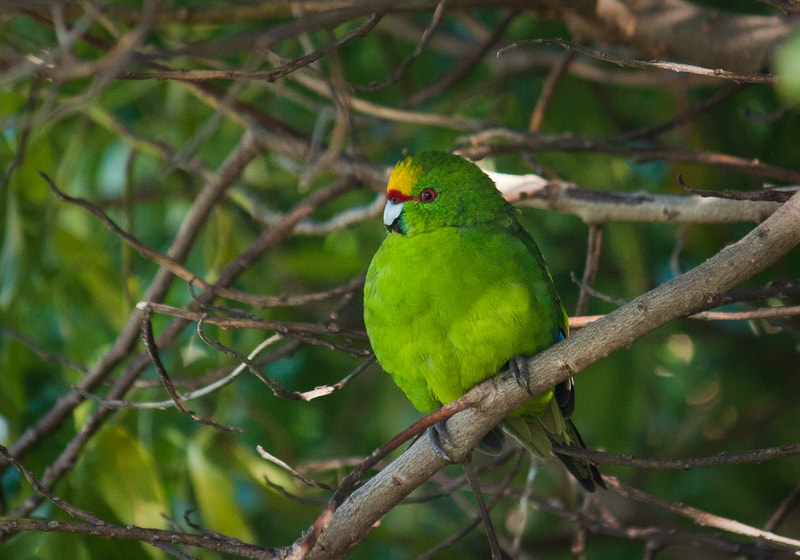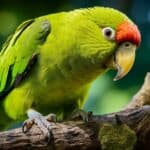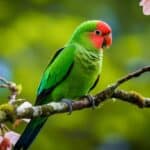Kakariki yellow, also known as the yellow-crowned parakeet, is a native bird species of New Zealand. It is a small, brightly coloured bird, with a yellow crown and green feathers on its body. The species is known for its playful and active nature, making it a popular pet bird among bird enthusiasts.
In the wild, Kakariki yellow can be found in various habitats, including forests, shrublands, and grasslands. The species is known for its adaptability, and it can thrive in both natural and human-modified environments. However, due to habitat loss and predation by introduced species, such as rats and stoats, the population of Kakariki yellow has declined significantly in recent years, and the species is now classified as “nationally vulnerable” in New Zealand.
Despite the challenges facing the species, conservation efforts are underway to protect and restore the population of Kakariki yellow. These efforts include predator control, habitat restoration, and captive breeding programmes. With continued conservation efforts, it is hoped that the species will recover and thrive in the wild for generations to come.
Origin and Habitat
Native Land
The Kakariki Yellow, also known as the Yellow-crowned Parakeet, is a small, predominantly green parrot that is native to New Zealand. There are three subspecies of the Kakariki, all of which are endemic to New Zealand and its offshore islands. The Yellow-crowned subspecies is found on the North Island and the northern part of the South Island.
Habitat Characteristics
Kakariki Yellow parrots are typically found in forested areas, particularly in beech forests. They are also known to inhabit scrubland and grassland areas, as well as suburban gardens and parks. These parrots are highly adaptable and can live in a variety of habitats, including areas disturbed by human activity.
Kakariki Yellow parrots are most commonly found at elevations below 1,000 meters, although they have been known to inhabit higher elevations in some areas. They are social birds and are often found in small flocks, although they may also be seen alone or in pairs.
The Kakariki Yellow is a diurnal species, meaning that it is active during the day and sleeps at night. It feeds on a variety of seeds, fruits, and insects, and is an important seed disperser for many plant species in its native habitat.
Overall, the Kakariki Yellow is a fascinating and adaptable species that is well-suited to life in the forests and grasslands of New Zealand. Its bright colours and cheerful personality make it a popular pet among bird enthusiasts, although it is important to note that captive breeding of this species is strictly regulated and should only be undertaken by experienced breeders.
Physical Characteristics
Kakariki yellow, also known as yellow-fronted kakariki, is a small parrot species that is native to New Zealand. This bird species has distinct physical characteristics that make them stand out from other parrot species.
Colour and Markings
Kakariki yellow has a bright green plumage with a yellow crown and forehead. They also have a red patch on their forehead, which is more prominent in males. The wings of the Kakariki yellow are bright green with a yellow and black pattern on the tips. The tail feathers are also green with a yellow tip.
Size and Weight
Kakariki yellow is a small parrot species, with an average length of 27 cm (10.6 inches) and a weight of approximately 65 grams (2.3 ounces). They have a wingspan of around 5 inches.
In terms of size, the Kakariki yellow is similar to other parrot species such as the black-headed caique and the jenday conure. However, their distinct green and yellow plumage, along with their small size, make them easy to identify.
Overall, the physical characteristics of the Kakariki yellow make them a unique and beautiful parrot species. Their bright green and yellow plumage, along with their small size, make them a popular choice among bird enthusiasts.
Behaviour and Temperament
Social Behaviour
Kakariki yellow is a social bird that thrives on interaction with its owner and other birds. They are known to be affectionate, intelligent, and playful, making them great pets for those who enjoy spending time with their feathered friends. These birds enjoy being part of a flock and are happiest when they have companionship. They are also known to be quite vocal, with a range of natural calls, chatterer, mimics, and talkers.
Activity Level
Kakariki yellow is an active bird that requires plenty of space to fly and climb. They are energetic and fun, making them great pets for those who enjoy an active lifestyle. These birds are known for their love of play and will spend hours exploring their surroundings. They also enjoy toys and other forms of stimulation, so it’s important to provide them with plenty of entertainment options.
In summary, Kakariki yellow is a social and active bird that thrives on interaction with its owner and other birds. They are affectionate, intelligent, and playful, making them great pets for those who enjoy spending time with their feathered friends. These birds require plenty of space to fly and climb and enjoy toys and other forms of stimulation.
Diet and Nutrition
Feeding Habits
Kakariki yellow is a species of parrot that thrives on a varied diet. In the wild, they feed on a range of foods such as fruits, berries, seeds, flowers, insects, and nectar. In captivity, it is important to provide them with a similar variety of foods to ensure they receive all the necessary nutrients.
Kakariki yellow is an active bird, and they require a lot of energy to maintain their high metabolism. Therefore, they need a diet that is high in carbohydrates, protein, and fat. They enjoy eating fresh fruits and vegetables, such as apples, oranges, carrots, and broccoli. They also enjoy eating seeds, nuts, and grains.
Nutritional Requirements
Kakariki yellow requires a diet that is rich in vitamins and minerals. They need a balanced diet that includes carbohydrates, protein, fat, calcium, and vitamin A. It is important to provide them with a variety of foods to ensure they receive all the necessary nutrients.
It is recommended to feed them with a high-quality pellet diet that is specifically formulated for parrots. These pellets contain all the necessary vitamins and minerals that they need. It is also important to provide them with fresh fruits and vegetables daily.
In addition, Kakariki yellow requires access to clean water at all times. They need to be provided with fresh water daily, and their water bowl should be cleaned regularly to prevent the growth of harmful bacteria.
Overall, providing a balanced and varied diet is crucial for the health and well-being of Kakariki yellow. By offering them a range of foods, you can ensure that they receive all the necessary nutrients to maintain their health and vitality.
Breeding and Reproduction
Kakariki yellow is a species of parrot that can be bred in captivity. Breeding Kakariki yellow requires a large aviary of at least 3.5 x 1 x 2 m (10 x 3 x 6 ft) in size, with protection from winter frost. A heated shelter may be necessary. A colony system with other species is possible even when breeding.
Mating Rituals
Kakariki yellow parrots form monogamous pairs during breeding season. The male will court the female by bowing and bobbing his head, puffing up his feathers, and making vocalizations. Once the female accepts the male’s advances, she will signal her readiness to mate by crouching on a perch and lifting her tail feathers.
Offspring Care
Kakariki yellow females will lay up to 13 eggs, but the more usual number is 6-9. Once the eggs hatch, the parents will take turns feeding and caring for the chicks. The chicks will fledge after around 30 days, but they will still depend on their parents for food for several weeks. It is important to provide a good quality seed mix consisting of millet, canary grass seed, oats, some sunflower (also sprouted) and hemp to ensure the parents have enough nutrition to feed their young.
In conclusion, breeding Kakariki yellow requires a large aviary with the right conditions, and the parrots form monogamous pairs during breeding season. Once the eggs hatch, the parents will take turns feeding and caring for the chicks.
Kakariki Yellow: Health and Lifespan
Common Health Issues
Kakariki yellow parrots are generally healthy birds, but they are susceptible to some common health issues. The following table lists some of the most common health problems that can affect Kakariki yellow parrots:
| Health Issue | Symptoms | Treatment |
|---|---|---|
| Psittacosis | Lethargy, loss of appetite, weight loss, respiratory problems | Antibiotics |
| Feather plucking | Self-mutilation, bald patches, skin irritation | Behavioural modification, environmental enrichment |
| Beak overgrowth | Overgrown beak, difficulty eating | Trimming, dietary changes |
| Vitamin A deficiency | Weight loss, lethargy, respiratory problems, eye problems | Vitamin A supplementation, dietary changes |
It is important to take your Kakariki yellow parrot to a veterinarian at the first sign of any health issues to ensure prompt treatment and a quick recovery.
Average Lifespan
Kakariki yellow parrots have an average lifespan of 10-15 years in captivity. With proper care and attention, some Kakariki yellow parrots have been known to live up to 20 years or more.
To ensure your Kakariki yellow parrot lives a long and healthy life, it is important to provide a balanced diet, a clean and spacious living environment, and regular veterinary check-ups. Additionally, providing plenty of mental and physical stimulation through toys, activities, and social interaction can help prevent boredom and promote overall health and wellbeing.
In conclusion, understanding common health issues and average lifespan is important for providing the best care for your Kakariki yellow parrot. With proper care and attention, your feathered friend can live a long and happy life.
Conservation Status
The yellow-crowned parakeet, also known as the Kakariki, is a small, forest-dwelling parrot native to New Zealand. According to New Zealand Birds Online, the conservation status of this species is currently listed as “Declining”.
Although the yellow-crowned parakeet was once very common throughout New Zealand, it is now rare or uncommon in most places on the mainland. The species is considered to be endemic, meaning it is only found in New Zealand.
Despite being classified as “not threatened”, the yellow-crowned parakeet is still at risk due to habitat loss and predation by introduced mammalian predators such as rats, stoats, and possums. In addition, the species is vulnerable to disease, particularly avian malaria.
Efforts are being made to protect and conserve the yellow-crowned parakeet. The New Zealand Department of Conservation is working to control introduced predators and restore the parakeet’s habitat. Captive breeding programmes have also been established to help increase the population of this species.
Overall, the conservation status of the yellow-crowned parakeet is a cause for concern, but conservation efforts are underway to help protect and conserve this unique and beautiful bird.
Interaction with Humans
Kakariki yellow parrots are known for their social and affectionate nature, making them great pets for those who seek companionship. These parrots love to interact with humans and thrive on attention. They have been known to form strong bonds with their owners and enjoy spending time with them.
Kakariki yellow parrots are intelligent birds and can be trained to perform tricks and learn basic commands. They enjoy learning new things and require mental stimulation to keep them happy and healthy. Owners can use positive reinforcement techniques such as treats and praise to encourage good behaviour and discourage bad behaviour.
It is important to note that Kakariki yellow parrots require a lot of attention and interaction from their owners. They do not do well in isolation and can become bored and destructive if left alone for too long. Owners should be prepared to spend time with their parrots every day, providing them with plenty of toys and activities to keep them occupied.
When interacting with Kakariki yellow parrots, it is important to approach them slowly and calmly. These birds can be easily startled and may become aggressive if they feel threatened. Owners should also be aware that Kakariki yellow parrots can be quite vocal and may make loud noises during the day.
Overall, Kakariki yellow parrots make great pets for those who are willing to invest time and effort into their care. With proper training and socialisation, these birds can become loving and affectionate companions for many years to come.
Yellow Kakariki: FAQ’s
What are yellow Kakarikis called?
Yellow Kakarikis, a variety of parakeet, are also known as Yellow-fronted Parakeets. They originate from New Zealand. This parakeet type stands out due to its vibrant yellow plumage, hence the name.
Can yellow kakariki talk?
Yes, yellow kakarikis can talk. These parakeets have the ability to mimic human speech, although their vocal skills may not be as advanced as some other parrot species. With consistent training, they can learn a few words and phrases.
How big are yellow Kakarikis?
Yellow Kakarikis, or Yellow-fronted Parakeets, are relatively small birds. They usually measure between 25 to 30 cm (10 to 12 inches) in length from the beak to the tip of the tail when fully grown.



Have comments or questions about this article? Then get involved!
Spotted an error or something we have missed? Let us know